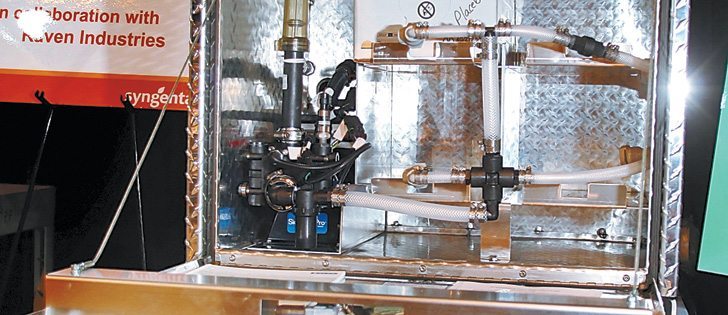Collaborative effort | John Deere, Raven and Syngenta work together for alternative to tank mixes and dust of dry insecticide
DURHAM, N.C. — A new chemical application system marries agronomy with machinery.
The soil-applied insecticide tool for corn planters puts chemicals in the soil without producers coming into contact with the product.
The closed application system for liquid Force CS can also be used to put liquid fertilizer down with the seed. It was developed by John Deere, Raven and Syngenta.
Vern Hawkins, who heads up Syngenta’s North American business, said the company is looking at overall delivery and development of technology and services, which means thinking more like a farmer.
Read Also

Agritechnica Day 3: Hybrid drive for a combine, data standards keep up to tech change and tractors of the year
Agritechnica 2025 Day 3: Hybrid drive for a combine, data standards keep up to tech change and tractors of the year.
“Putting agronomy to work can mean problem solving with equipment partners,” he said.
“That’s not traditional crop protection company thinking.”
Kevin Fite of the company’s research group in Greensborough, North Carolina, said development of the soil applied insecticide system predates the new corporate strategy, but it reflects the importance that the company places on thinking like a farmer.
“We were given a problem: precision delivery of an insecticide to the seed (row) with as little farmer contact with the product as possible and little or no waste,” he said.
“So we worked with John Deere on one of their planters and Raven on pumps and delivery. We refined our product and packaging and we came up with a solution.”
Each of the partners brought their expertise to the problem rather than their “stuff,” said Fite.
“It wasn’t just us saying, ‘here is our chemical, make it work,’ and it wasn’t them saying, ‘here is our metering and our machinery, hope it works with your insecticide.’ ”
Syngenta said it wanted an alternative to the dust of dry granule Tefluthrin or the tank mixing of the insecticide with a water or fertilizer carrier.
The partners came up with a Deere unit that allows producers to place up to eight boxed, 2.5 U.S. gallon bladders filled with Syngenta’s Force CS, enough to cover up to 320 acres, and delivered it along with liquid fertilizer or water. It can be managed from the cab, including setting refuge rows.
“Raven now has their own version that works with any brand of planter. It holds four boxes and works with most (brands of) electronics systems out there,” Fite said.
“No one company would have done this in this way. It needed to be a collaboration. And we needed to think about what a farmer might do to solve the problem.”
The Raven Sidekick Pro delivers the product, which controls cutworms, rootworms, wireworms, white grubs and corn seed maggots. In its first version, Deere worked out the delivery and housing of the product.
The Raven units can deliver product in two ranges: one to 10 ounces per minute and five to 40 using pressure-side injection, which rapidly puts the chemical in place on demand.
The liquid version of the chemical encapsulates the insecticide within its structure, resulting in less soil binding, longer activity in the soil, reduced losses to evaporation, crop damage and operator exposure.
“Integration is bringing different parts of our company together, working together and letting each other know what we are doing and what problems we have,” Fite said.
“It’s a model we used to solve this problem. We just did it before it was a corporate strategy.”















